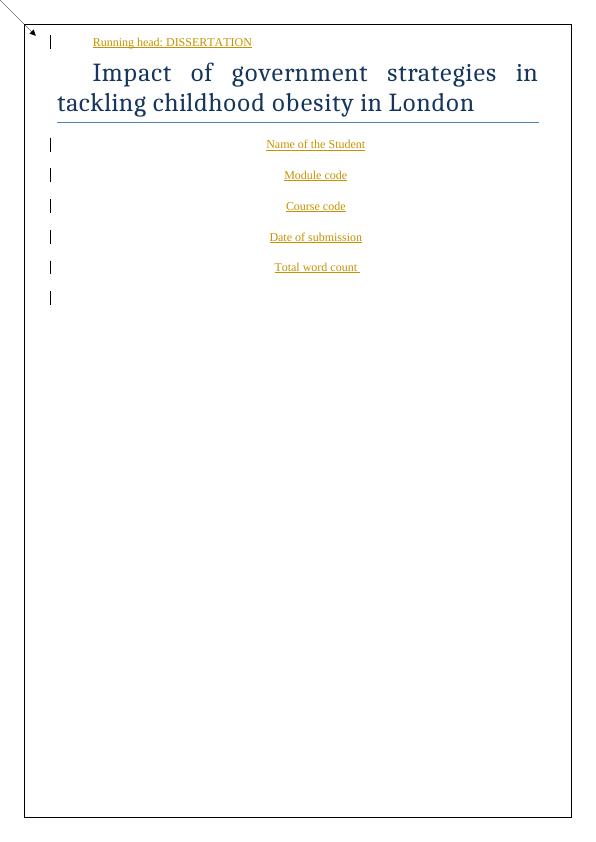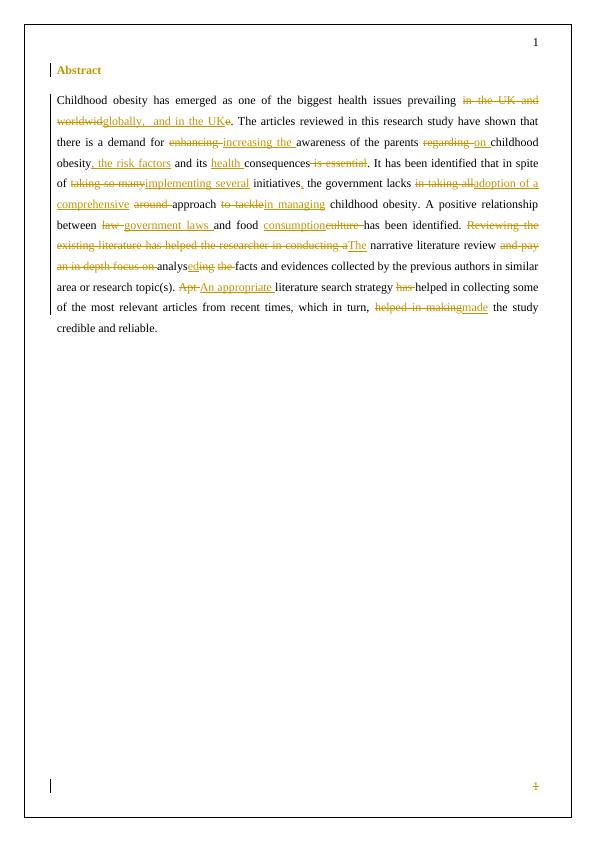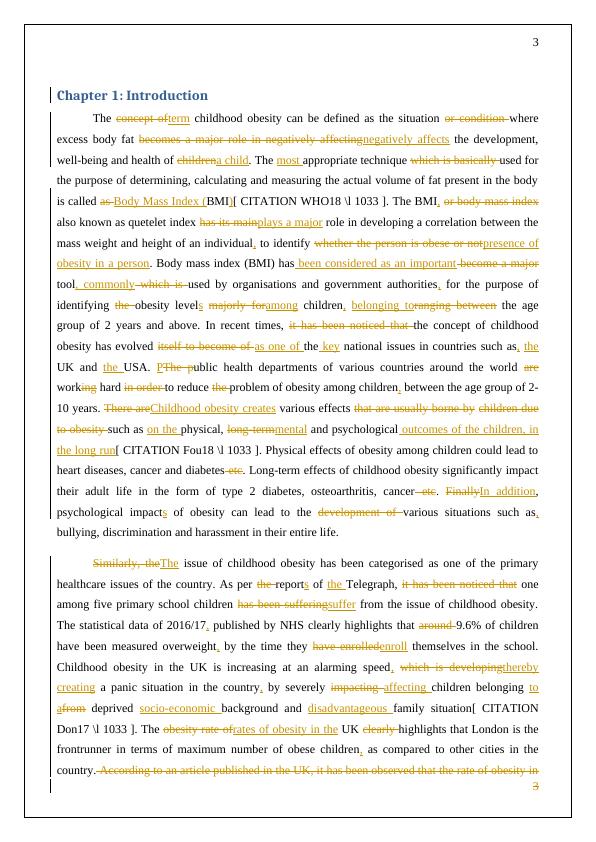Ask a question from expert
Childhood Obesity in London - PDF
27 Pages8675 Words133 Views
Added on 2021-05-31
Childhood Obesity in London - PDF
Added on 2021-05-31
BookmarkShareRelated Documents
Running head: DISSERTATIONImpact of government strategies intackling childhood obesity in LondonName of the StudentModule codeCourse codeDate of submissionTotal word count

1AbstractChildhood obesity has emerged as one of the biggest health issues prevailing in the UK andworldwidglobally, and in the UKe. The articles reviewed in this research study have shown thatthere is a demand for enhancing increasing the awareness of the parents regarding onchildhoodobesity, the risk factors and its health consequences is essential. It has been identified that in spiteof taking so manyimplementing several initiatives, the government lacks in taking alladoption of acomprehensivearound approach to tacklein managing childhood obesity. A positive relationshipbetween law government laws and food consumptionculture has been identified. Reviewing theexisting literature has helped the researcher in conducting aThe narrative literature review and payan in depth focus on analysedingthe facts and evidences collected by the previous authors in similararea or research topic(s). Apt An appropriateliterature search strategy has helped in collecting someof the most relevant articles from recent times, which in turn, helped in makingmade the studycredible and reliable. 1

2Table of ContentsChapter 1: Introduction............................................................................................................3Chapter 2: Research background, context and rationale..........................................................4Research aim....................................................................................................................5Research objective............................................................................................................5Chapter 3: Literature Search Strategy-.....................................................................................6Chapter 4-Main Findings from the Literature Reviewed.......................................................14Chapter 5- Discussion & Conclusion.....................................................................................18Discussion......................................................................................................................18Conclusion......................................................................................................................20References..............................................................................................................................222

3Chapter 1: IntroductionThe concept ofterm childhood obesity can be defined as the situation or condition whereexcess body fat becomes a major role in negatively affectingnegatively affects the development,well-being and health of childrena child. The most appropriate technique which is basically used forthe purpose of determining, calculating and measuring the actual volume of fat present in the bodyis called as Body Mass Index (BMI)[ CITATION WHO18 \l 1033 ]. The BMI,or body mass indexalso known as quetelet index has its mainplays a major role in developing a correlation between themass weight and height of an individual, to identify whether the person is obese or notpresence ofobesity in a person. Body mass index (BMI) has been considered as an important become a majortool, commonly which is used by organisations and government authorities, for the purpose ofidentifying the obesity levelsmajorly foramong children,belonging toranging between the agegroup of 2 years and above. In recent times, it has been noticed that the concept of childhoodobesity has evolved itself to become of as one of the key national issues in countries such as,theUK and the USA. PThe public health departments of various countries around the world areworking hard in order to reduce the problem of obesity among children, between the age group of 2-10 years. There areChildhood obesity creates various effects that are usually borne bychildren dueto obesity such as on the physical, long-termmental and psychological outcomes of the children, inthe long run[ CITATION Fou18 \l 1033 ]. Physical effects of obesity among children could lead toheart diseases, cancer and diabetes etc. Long-term effects of childhood obesity significantly impacttheir adult life in the form of type 2 diabetes, osteoarthritis, cancer etc. FinallyIn addition,psychological impacts of obesity can lead to the development of various situations such as,bullying, discrimination and harassment in their entire life. Similarly, theThe issue of childhood obesity has been categorised as one of the primaryhealthcare issues of the country. As per the reports of the Telegraph, it has been noticed that oneamong five primary school children has been sufferingsuffer from the issue of childhood obesity.The statistical data of 2016/17, published by NHS clearly highlights that around 9.6% of childrenhave been measured overweight, by the time they have enrolledenroll themselves in the school.Childhood obesity in the UK is increasing at an alarming speed,which is developingtherebycreating a panic situation in the country, by severely impacting affecting children belonging toafrom deprived socio-economic background and disadvantageous family situation[ CITATIONDon17 \l 1033 ]. The obesity rate ofrates of obesity in the UK clearly highlights that London is thefrontrunner in terms of maximum number of obese children, as compared to other cities in thecountry. According to an article published in the UK, it has been observed that the rate of obesity in3

4the city of London is higher as compared to other parts of the nation. The primary reason behind therise of obesity among children is mostly due to the presence ofprevalence of fast food businesses inthe country[ CITATION CRE15 \l 1033 ]. The Labour mayoral candidate of UK, Mr Sadiq Khanhas taken a bold decision in order to minimise the frequency of obesity among children. Khan hasintroduced health practices, which would restrict fast food outlets to set up their stores within 400metres of the school.4

5Chapter 2: Research background, context and rationaleOver the years, Cchildhood obesity from the past has gained huge noticeimportance,especially in the European and American countries, owing to largely to their diet and lifestylepatterns. This has lead significantly led the development of various researchers which arestudies,undertaken by authors all over the world, in order to identify and develop strategies to overcome theissue of childhood obesity. SM (2015) has significantly focused on conducting an analysis of thedeterminants that leads to the occurrence of obesity and children, globally[CITATION SMM15 \l1033 ]. The few of the Some of the major determinants of child obesity are genetics, birth weight,and age and gender. The occurrence of obesity among children can arise from family genetics, if thewhen the BMI of the mother and the father are overweightindicates them to be overweight. Theaspect of fat mass and obesity associated genes, present within the child can surely result in rising inweight increase. The bBirth weight determinant is also a majoranother factor that leads to gain ofweight, in the future. The rapid increase in the weight of low weight infants should be considered asan alarming factorfor obesity in futureas there is a high chance of being obese in the future. Theimpact of childhood obesity has also forced the World Health Organisation (WHO) to developappropriate norms and policies,which are required to be followed by countries, in order to controlchildhood obesity. The statistical report of WHO clearly shows that the number associated withchildhood obesity has massively increased from 32 million globally in 1990, to 41 million childrenin the year 2016[ CITATION WHO181 \l 1033 ]. World Health Organisation (WHO) reported thatthe majority of cases of childhood obesity are generally from the African region. The increase ofobese children in the African region has risen from 4 million in 1990 to 9 million in 2016. The rateof childhood obesity is recorded to be high in developing countries, as compared to developednations. However,there is no denying but that does not deny the fact that developed countries suchas the UK, the USA and Canada are taking immense several steps, by introducing new policies andregulations, to prevent further rise of childhood obesity in their respective countries. The rationale for conducting the research on childhood obesity is largely due to thecan bebased on the fact that this issue is one of the hot topics in the a global health concern, world andalso one of the most serious issues prevailing in the healthcare department of theacross alldeveloped and developing countries. The conductance ofConducting an analysis on the issue ofchildhood obesity would allow the readers to acquire an in-depth and accurate knowledgeunderstanding ofn the impact and causes that lead to the process of gaining excessive weightgaining, among children ranging between the age group of 2-7 years[ CITATION Kuh151 \l 1033 ].This study would also look to discussillustrate the views of global authors and scholars who have5

End of preview
Want to access all the pages? Upload your documents or become a member.
Related Documents
Childhood Obesity: Impacts on Emotional and Social Developmentlg...
|17
|4624
|459
Social factors that contribute to obesity in children from black and minority ethnic grouplg...
|25
|11145
|147
Impact of Obesity on Psychological Well-being of Youthlg...
|9
|1672
|212
Childhood Obesity: Causes, Consequences and Prevention Strategieslg...
|6
|1570
|206
Role of physical activity on psychological consequences of childhood obesity later in lifelg...
|14
|2456
|149
Childhood Obesity: Causes, Effects, and Preventionlg...
|10
|3755
|4